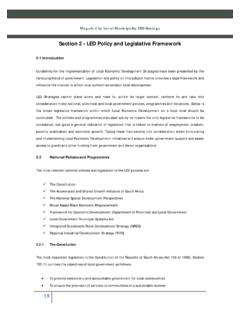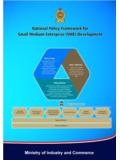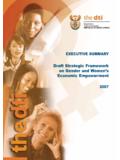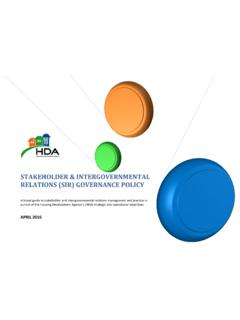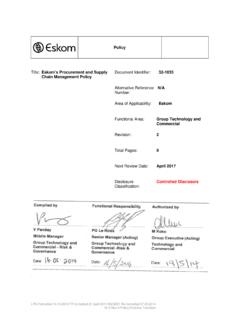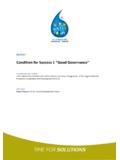Transcription of chapter 4 National medicine policy - WHO
1 Part I: policy and economic issues Part II: Pharmaceutical management Part III: Management support systems policy and legal framework 1 Toward sustainable access to medicines 2 Historical and institutional perspectives 3 Intellectual property and access to medicines 4 National medicine policy 5 Traditional and complementary medicine policy 6 Pharmaceutical legislation and regulation 7 Pharmaceutical production policy 8 Pharmaceutical supply strategies Financing and sustainability chap ter 4. National medicine policy Summary illustration Introduction Figure 4-1 Structure of a complete National medicine policy What is a National medicine policy ? What should a medicine policy accomplish? What b oxes approaches should be used? Why do medicine policies differ by country? Who are the main participants in Box 4-1 List of stakeholders who provided input in the developing and implementing a National medicine policy ?
2 2004 revision of Ghana's National medicine policy Components of a National medicine policy Box 4-2 Components of a National medicine policy Legislative and regulatory framework Choice of essential Box 4-3 Objectives of Malawi's 2009 National medicine medicines Supply Affordability Financing policy strategies Rational medicine use Human resources, Box 4-4 Access to essential medicines as part of the monitoring, evaluation, and research fulfillment of the right to health Setting priorities c ountry studies Formulating a National medicine policy Step 1. Organize the policy process Step 2. Identify and CS 4-1 Using operations research to develop and implement analyze problems Step 3. Set goals and objectives the Lao National Drug policy Step 4. Draft the policy Step 5. Circulate and revise CS 4-2 Innovative approaches in formulating and the policy Step 6. Obtain formal endorsement for the implementing a National medicine policy in policy Step 7.
3 Launch the policy Australia CS 4-3 When things go wrong with National medicine Implementing a National medicine policy policies: the case of Yemen Monitoring and evaluating a National medicine policy Constraints and facilitating factors Assessment guide References and further readings copyright management sciences for health 2012. P olicy and l e gal fram ewor k s u mm a r y A National medicine policy (NMP) is a political commit- difficulty in implementing and enforcing laws and regu- ment and a guide for action that shows how the govern- lations that already exist; issues of finance, supply, cost, ment will ensure that efficacious and safe medicines of and pricing; and rational use of medicines. Less pressing good quality are affordable, accessible, and rationally matters may be addressed later. used. The NMP provides a framework for coordinating This chapter reviews the main steps in formulating an the activities of all the parties involved, such as the pub- NMP including.
4 Lic and private sectors, nongovernmental organizations (NGOs), donors, and other interested stakeholders; it Organizing the process also defines the role that the public itself should play. Identifying and analyzing problems Setting goals and objectives The medicine policy of one country may be similar in Drafting the policy many ways to the medicine policies of other countries, Seeking wide agreement on the policy but because their starting situations will vary, the policies Obtaining formal endorsement of the policy will likely differ in what they emphasize and in how prob- Launching the policy lems can best be tackled. A National government will be the principal agency responsible for creating the overall Formulating a policy is one thing; putting it into effect NMP and putting it into practice; however, collaboration is another. No single, best way to implement an NMP.
5 Will be needed with prescribers, dispensers, consumers, exists, but this chapter shares the approaches that some and those who make, market, distribute, and sell medi- countries have taken. cines. Sometimes, disagreements among the parties will Experience shows that the essential medicines concept be unavoidable because their interests differ, but ideally a is central to a successful National medicine policy . The wide partnership will develop, because an effective medi- core of the concept is using an established list of essen- cine policy is ultimately in the best interests of all. tial medicines based on standard treatment guidelines, This chapter examines the components of an NMP. leading to a better supply of medicines, more rational Countries must choose the elements most relevant to prescribing, and lower costs. Finally, the success of an their situation and most realistic, given their available NMP will depend heavily on political commitment by human and financial resources.
6 At the outset, govern- the government and support from all stakeholders in the ments will need to give priority to solving current prob- pharmaceutical sector. lems, such as a lack of relevant laws and regulations and Introduction which medicines were being prescribed or used by patients. The result in some instances was that access to medicines For many decades, pharmaceutical policies were developed improved, but people did not know how to use them ratio- in a piecemeal fashion, where they existed at all. At one nally. Similarly, essential medicines policies developed for moment, a country may have developed a regulation on the public sector only were ineffectual because they did not pharmaceutical advertising at another moment, a decree address how the private and public sectors could comple- on the places where medicines can be sold. One country ment each another. More recently, some East African might concentrate on sound manufacturing practice countries' difficulties in collecting direct taxes have led another country on the problem of providing very poor to a heavier reliance on import duties and manufacturing populations with access to medicines.
7 Only gradually did taxes, including those from medicines. This policy makes people come to realize that the issue of medicines and their imported pharmaceuticals more expensive and discourages proper place in society needed to be looked at as a whole. local production, resulting in the availability of fewer low- If a policy covered only select issues in the pharmaceuti- cost medicines in the marketplace. cal sector, problems could soon arise with other issues; in These experiences suggested that pharmaceutical prob- fact, a one-sided approach might actually make a situation lems might be better tackled within a common frame- worse. work created through the development of a comprehensive In the 1970s, for example, efforts were made in certain National medicine policy . The overall goal of an NMP should countries to solve problems involving pharmaceutical pro- be to promote equity and sustainability of the pharmaceuti- curement and distribution without examining the ways in cal sector (WHO 2003).
8 Its general objectives can be simply 4 / National medicine policy Figure 4-1 Structure of a complete National medicine policy A. Consensus on Methods Input to Drug Policies DUR Methods Global Trends Research/Therapy Official Guidelines Studies of Future DUR Studies Staff Training policy Audits policy Needs Foreign Influences National Drug Policies Legal Lobbies B. policy Tools Education ADR Study Costs Distribution Advertising Ind. Information Res. Funds Registration Quality C. Channels Universities, Schools Pharmaceutical Industry Dispenser (Pharmacist, MD) Prescriber (MD). D. Objective Acceptable, Affordable, Accessible Drugs That Are Rationally Used E. Corrective Mechanisms Courts of Justice Consumer Bodies Public Acceptance Mass Media DUR = drug use review; ADR = adverse drug reaction; Ind. = Independent; Res. = Research. This figure shows how many different elements are linked in the construction of a National medicine policy .
9 No individual country's policy is likely to be structured in exactly the same way, and many National medicine policies are simpler. The chart can, however, be useful in analyzing the situation and looking for solutions. For example, the area of rational prescribing can be analyzed by examining the linkages illustrated. The figure shows that the prescriber is likely to receive information, advice, and persuasion from various sources: the institution where he or she was educated, the drug regulatory agency, formularies, industry representatives, and others. Can the quality of influencing sources be improved? Do they reinforce or contradict one another? Is some better form of guidance needed if the prescriber is to improve rational prescribing practices? stated: a National medicine policy should ensure that effec- What is a National medicine policy ? tive and safe medicines of good quality are accessible and affordable to the entire population and that they are ratio- An NMP is a political commitment to a goal and a guide for nally used.
10 Action. It is a written document specifying the medium- to The 1980s saw the idea of an NMP emerging as a posi- long-term goals set by the government for the pharmaceu- tive concept, and the World Health Organization (WHO) tical sector, their relative importance, and the main strate- and World Bank became active in developing the idea gies for attaining them. Moreover, it provides a framework further. Now the idea that every country should try to for coordinating activities of the pharmaceutical sector: achieve optimal availability, quality, and use of medicines the public and private sectors, NGOs, donors, and other for patients and consumers is widely accepted. By 2007, interested parties. (Figure 4-1 illustrates the structure of a more than 130 countries had formulated NMPs, about 60 National medicine policy .) The NMP should be incorporated percent of which had an updated implementation plan in into the National health system to ensure that NMP goals place (WHO 2010).










